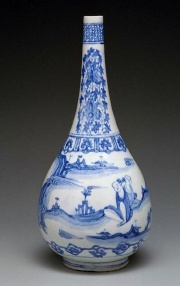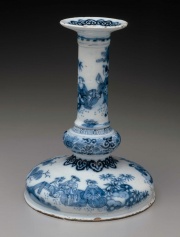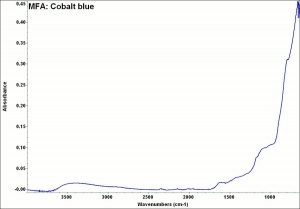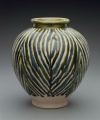Difference between revisions of "Cobalt blue"
(username removed) |
(username removed) |
||
| Line 2: | Line 2: | ||
== Description == | == Description == | ||
| − | A clear blue pigment. (Some early varieties possessed a greenish tinge.) Cobalt blue is composed of a double oxide of cobalt and aluminum, also called cobaltous aluminate. It is resistant to weathering, sunlight, acids, and alkalis. Though possibly discovered earlier, the process for making cobalt blue by heating [http://cameo.mfa.org/materials/fullrecord.asp?name=cobaltous | + | A clear blue pigment. (Some early varieties possessed a greenish tinge.) Cobalt blue is composed of a double oxide of cobalt and aluminum, also called cobaltous aluminate. It is resistant to weathering, sunlight, acids, and alkalis. Though possibly discovered earlier, the process for making cobalt blue by heating [http://cameo.mfa.org/materials/fullrecord.asp?name=cobaltous%20phosphate cobalt phosphate] with [http://cameo.mfa.org/materials/fullrecord.asp?name=alumina alumina] was first published by L.J.Thnard in France in 1803/4 based on experiments he had carried out in 1802. Leithner discovered an alternate process for making cobalt blue from [http://cameo.mfa.org/materials/fullrecord.asp?name=cobaltous%20arsenate cobalt arsenate] and alumina. By the early 19th century, cobalt blue was sold as an artists pigment as a replacement for smalt and ultramarine, although it has always been relatively costly. The pigment has been identified in French and British paintings as early as 1806/07. In recent years, the cobalt blue hue has been imitated using mixtures of [http://cameo.mfa.org/materials/fullrecord.asp?name=ultramarine%20blue%2C%20synthetic ultramarine] and [http://cameo.mfa.org/materials/fullrecord.asp?name=phthalocyanine%20blue phthalocyanine]. The saturated cobalt blue color in glazes and glassware is produced by [http://cameo.mfa.org/materials/fullrecord.asp?name=cobaltic%20oxide cobalt oxide]. |
[[File:08.475-CR10038-d1.jpg|thumb|]] | [[File:08.475-CR10038-d1.jpg|thumb|]] | ||
Revision as of 12:02, 13 June 2013
Description
A clear blue pigment. (Some early varieties possessed a greenish tinge.) Cobalt blue is composed of a double oxide of cobalt and aluminum, also called cobaltous aluminate. It is resistant to weathering, sunlight, acids, and alkalis. Though possibly discovered earlier, the process for making cobalt blue by heating cobalt phosphate with alumina was first published by L.J.Thnard in France in 1803/4 based on experiments he had carried out in 1802. Leithner discovered an alternate process for making cobalt blue from cobalt arsenate and alumina. By the early 19th century, cobalt blue was sold as an artists pigment as a replacement for smalt and ultramarine, although it has always been relatively costly. The pigment has been identified in French and British paintings as early as 1806/07. In recent years, the cobalt blue hue has been imitated using mixtures of ultramarine and phthalocyanine. The saturated cobalt blue color in glazes and glassware is produced by cobalt oxide.
Synonyms and Related Terms
cobalt aluminate; Pigment Blue 28; CI 77346; Thnard's blue; Kobaltblau (Deut.); bleu de Thnard (Fr.); bleu de cobalt (Fr.); cobaltblauw (Ned.); blu di cobalto (It.); blu di Therard (It.); mple toy kobaltioy (Gr.); azul de cobalto (Esp.); azul cobalto (Port.); cobalt ultramarine; cobaltous aluminate; king's blue; Olympia blue; Vienna blue; Vienna ultramarine; Leyden blue; Hungary blue; Dresden blue; azure cobalt; Gahn's blue; Leithner blue; new blue;
Other Properties
Irregular to rounded blue particles with a crusty surface, no birefringence, no pleochroism. Appears red through Chelsea filter.
Unaffected by acids, alkalis, light, and heat.
Strong siccative properties in oil on account of the cobalt content.
| Composition | CoO.Al2O3 |
|---|---|
| Density | 3.83 |
| Refractive Index | 1.66-1.74 |
Hazards and Safety
Skin contact may cause allergies, especially on elbows, neck and ankles. Chronic inhalation may cause asthma.
Ingestion may cause vomiting, diarrhea and the sensation of hotness.
Additional Information
A. Roy, Cobalt Blue, Artists Pigments: A Handbook of Their History and Characteristics, Volume 4, B. Berrie (ed.), Archetype Publications, London 2007. Pigments Through the Ages: Cobalt blue Record content reviewed by EU-Artech November 2007.
Comparisons
Characteristics of Common Blue Pigments
Additional Images
Authority
- Nicholas Eastaugh, Valentine Walsh, Tracey Chaplin, Ruth Siddall, Nicholas Eastaugh, Valentine Walsh, Tracey Chaplin, Ruth Siddall, Pigment Compendium, Elsevier Butterworth-Heinemann, Oxford, 2004
- External source or communication, External source or communication Comment: Contributed information: Ashok Roy, November 2007.
- R. J. Gettens, G.L. Stout, R. J. Gettens, G.L. Stout, Painting Materials, A Short Encyclopaedia, Dover Publications, New York, 1966 Comment: p. 108
- Ralph Mayer, Ralph Mayer, A Dictionary of Art Terms and Techniques, Harper and Row Publishers, New York, 1969 (also 1945 printing)
- External source or communication, External source or communication Comment: Contributed information: Ashok Roy, November 2007.
- The Dictionary of Art, Grove's Dictionaries Inc., New York, 1996 Comment: "Pigments"
- M. Doerner, M. Doerner, The Materials of the Artist, Harcourt, Brace & Co., 1934
- Reed Kay, Reed Kay, The Painter's Guide To Studio Methods and Materials, Prentice-Hall, Inc., Englewood Cliffs, NJ, 1983
- R.D. Harley, R.D. Harley, Artists' Pigments c. 1600-1835, Butterworth Scientific, London, 1982
- Thomas B. Brill, Thomas B. Brill, Light Its Interaction with Art and Antiquities, Plenum Press, New York City, 1980
- David Bomford, Jo Kirby, John Leighton, Ashok Roy, David Bomford, Jo Kirby, John Leighton, Ashok Roy, Art in the Making:Impressionism, National Gallery, London, 1990
- G.S.Brady, G.S.Brady, Materials Handbook, McGraw-Hill Book Co., New York, 1971 Comment: p. 611
- Dictionary of Building Preservation, Ward Bucher, ed., John Wiley & Sons, Inc., New York City, 1996
- Michael McCann, Michael McCann, Artist Beware, Watson-Guptill Publications, New York City, 1979
- Website address 1, Website address 1 Comment: Pigments Through the Ages: http://webexhibits.org/pigments/indiv/overview/coblue.html
- Wikipedia, the free encyclopedia, at http://www.wikipedia.com Comment: http://en.wikipedia.org/wiki/Cobalt_blue (Accessed Jan. 15, 2006)
- CRC Handbook of Chemistry and Physics, Robert Weast (ed.), CRC Press, Boca Raton, Florida, v. 61, 1980 Comment: ref. index=1.74 (blue), >1.78 (red)
- Art and Architecture Thesaurus Online, http://www.getty.edu/research/tools/vocabulary/aat/, J. Paul Getty Trust, Los Angeles, 2000






